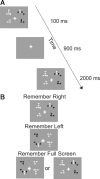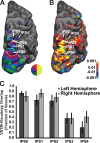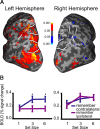Hemispheric asymmetry in visuotopic posterior parietal cortex emerges with visual short-term memory load
- PMID: 20861364
- PMCID: PMC3767385
- DOI: 10.1523/JNEUROSCI.2689-10.2010
Hemispheric asymmetry in visuotopic posterior parietal cortex emerges with visual short-term memory load
Abstract
Visual short-term memory (VSTM) briefly maintains a limited sampling from the visual world. Activity in the intraparietal sulcus (IPS) tightly correlates with the number of items stored in VSTM. This activity may occur in or near to multiple distinct visuotopically mapped cortical areas that have been identified in IPS. To understand the topographic and spatial properties of VSTM, we investigated VSTM activity in visuotopic IPS regions using functional magnetic resonance imaging. VSTM drove areas IPS0-2, but largely spared IPS3-4. Under visual stimulation, these areas in both hemispheres code the contralateral visual hemifield. In contrast to the hemispheric symmetry observed with visual stimulation, an asymmetry emerged during VSTM with increasing memory load. The left hemisphere exhibited load-dependent activity only for contralateral memory items; right hemisphere activity reflected VSTM load regardless of visual-field location. Our findings demonstrate that VSTM induces a switch in spatial representation in right hemisphere IPS from contralateral to full-field coding. The load dependence of right hemisphere effects argues that memory-dependent and/or attention-dependent processes drive this change in spatial processing. This offers a novel means for investigating spatial-processing impairments in hemispatial neglect.
Figures






Similar articles
-
Influences of Long-Term Memory-Guided Attention and Stimulus-Guided Attention on Visuospatial Representations within Human Intraparietal Sulcus.J Neurosci. 2015 Aug 12;35(32):11358-63. doi: 10.1523/JNEUROSCI.1055-15.2015. J Neurosci. 2015. PMID: 26269642 Free PMC article.
-
Visual Short-Term Memory Activity in Parietal Lobe Reflects Cognitive Processes beyond Attentional Selection.J Neurosci. 2018 Feb 7;38(6):1511-1519. doi: 10.1523/JNEUROSCI.1716-17.2017. Epub 2018 Jan 8. J Neurosci. 2018. PMID: 29311140 Free PMC article.
-
Hemifield asymmetries differentiate VSTM for single- and multiple-feature objects.Atten Percept Psychophys. 2014 Aug;76(6):1609-19. doi: 10.3758/s13414-014-0689-0. Atten Percept Psychophys. 2014. PMID: 24874260 Free PMC article. Clinical Trial.
-
Attention maps in the brain.Wiley Interdiscip Rev Cogn Sci. 2013 Jul;4(4):327-340. doi: 10.1002/wcs.1230. Epub 2013 Feb 27. Wiley Interdiscip Rev Cogn Sci. 2013. PMID: 25089167 Free PMC article. Review.
-
Attention and active vision.Vision Res. 2009 Jun;49(10):1233-48. doi: 10.1016/j.visres.2008.06.017. Epub 2008 Aug 3. Vision Res. 2009. PMID: 18627774 Free PMC article. Review.
Cited by
-
Dissociations between spatial-attentional processes within parietal cortex: insights from hybrid spatial cueing and change detection paradigms.Front Hum Neurosci. 2013 Jul 16;7:366. doi: 10.3389/fnhum.2013.00366. eCollection 2013. Front Hum Neurosci. 2013. PMID: 23882202 Free PMC article.
-
Hemisphere-dependent attentional modulation of human parietal visual field representations.J Neurosci. 2015 Jan 14;35(2):508-17. doi: 10.1523/JNEUROSCI.2378-14.2015. J Neurosci. 2015. PMID: 25589746 Free PMC article.
-
Top-down cortical interactions in visuospatial attention.Brain Struct Funct. 2017 Sep;222(7):3127-3145. doi: 10.1007/s00429-017-1390-6. Epub 2017 Mar 20. Brain Struct Funct. 2017. PMID: 28321551 Free PMC article.
-
The representation of tool and non-tool object information in the human intraparietal sulcus.J Neurophysiol. 2013 Jun;109(12):2883-96. doi: 10.1152/jn.00658.2012. Epub 2013 Mar 27. J Neurophysiol. 2013. PMID: 23536716 Free PMC article.
-
Structural Variability within Frontoparietal Networks and Individual Differences in Attentional Functions: An Approach Using the Theory of Visual Attention.J Neurosci. 2015 Jul 29;35(30):10647-58. doi: 10.1523/JNEUROSCI.0210-15.2015. J Neurosci. 2015. PMID: 26224851 Free PMC article.
References
-
- Alvarez GA, Cavanagh P. Independent resources for attentional tracking in the left and right visual hemifields. Psychol Sci. 2005;16:637–643. - PubMed
-
- Barash S, Bracewell RM, Fogassi L, Gnadt JW, Andersen RA. Saccade-related activity in the lateral intraparietal area. I. Temporal properties; comparison with area 7a. J Neurophysiol. 1991;66:1095–1108. - PubMed
-
- Battaglia-Mayer A, Caminiti R, Lacquaniti F, Zago M. Multiple levels of representation of reaching in the parieto-frontal network. Cereb Cortex. 2003;13:1009–1022. - PubMed
-
- Bisiach E, Luzzatti C. Unilateral neglect of representational space. Cortex. 1978;14:129–133. - PubMed
Publication types
MeSH terms
Grants and funding
LinkOut - more resources
Full Text Sources
Molecular Biology Databases
